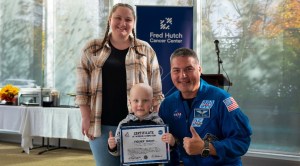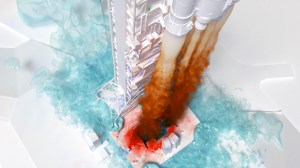2 min read
Preparations for Next Moonwalk Simulations Underway (and Underwater) To view this video please enable JavaScript, and consider upgrading to a web browser that supports HTML5 video
Designers at NASA’s Scientific Visualization Studio work alongside researchers and scientists to create high-quality, engaging animations and visualizations of data. This animation shows global carbon dioxide emissions forming and circling the planet.Credit: NASA’s Scientific Visualization Studio Captivating images and videos can bring data to life. NASA’s Scientific Visualization Studio (SVS) produces visualizations, animations, and images to help scientists tell stories of their research and make science more approachable and engaging.
Using the Discover supercomputer at the Center for Climate Simulation at NASA’s Goddard Space Flight Center in Greenbelt, Maryland, visualizers use datasets generated by supercomputer models to create highly detailed, accurate, and stunning visualizations with Hollywood filmmaking tools like 3D modeling and animation.
Using supercomputing models, SVS visualizers created this data-driven animation of carbon dioxide emissions moving around the planet. The visualization is driven by massive climate data sets and highly detailed emissions maps created by NASA researchers and external partners. The resulting visualization shows the impact of power plants, fires, and cities, and how their emissions are spread across the planet by weather patterns and airflow.
“Both policymakers and scientists try to account for where carbon comes from and how that impacts the planet,” said NASA Goddard climate scientist Lesley Ott, whose research was used to generate the final visualization. “You see here how everything is interconnected by the different weather patterns.”
By combining visual storytelling with supercomputing power, the SVS team continues their work to captivate and connect with audiences while educating them on NASA’s scientific research and efforts.
The NASA Center for Climate Simulation is part of the NASA High-End Computing Program, which also includes the NASA Advanced Supercomputing Facility at Ames Research Center in California’s Silicon Valley.
NASA is showcasing 29 of the agency’s computational achievements at SC24, the international supercomputing conference, Nov. 18-22, 2024, in Atlanta. For more technical information, visit:
For news media:
Members of the news media interested in covering this topic should reach out to the NASA Ames newsroom.
About the AuthorTara Friesen
Keep Exploring Discover More Topics From NASA Missions



 4 min read NASA Program Aids Pediatric Patients Facing Medical Treatments Article 1 hour ago
4 min read NASA Program Aids Pediatric Patients Facing Medical Treatments Article 1 hour ago  7 min read Six Ways Supercomputing Advances Our Understanding of the Universe Article 3 days ago
7 min read Six Ways Supercomputing Advances Our Understanding of the Universe Article 3 days ago  4 min read Article 3 days ago
4 min read Article 3 days ago 

